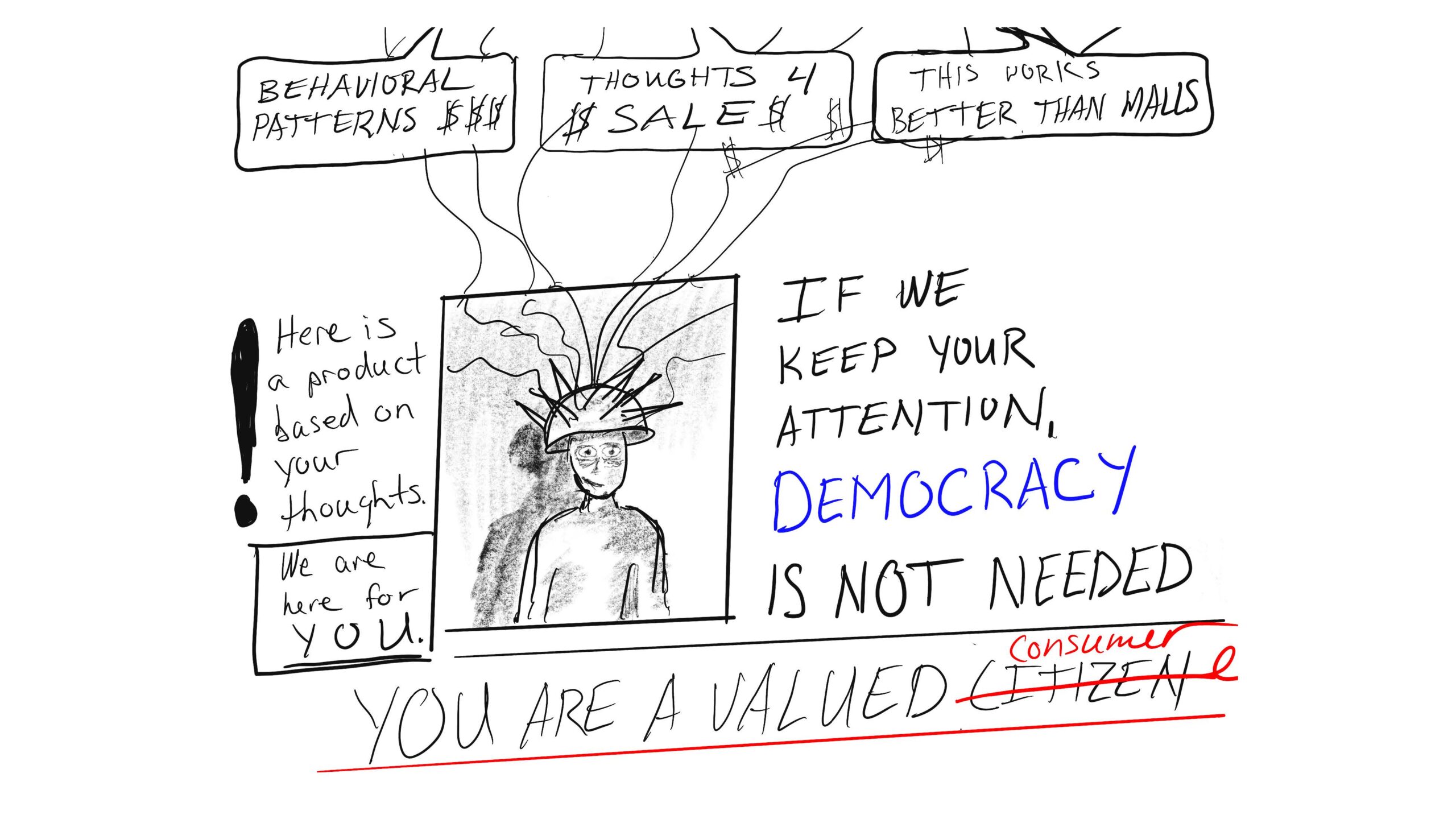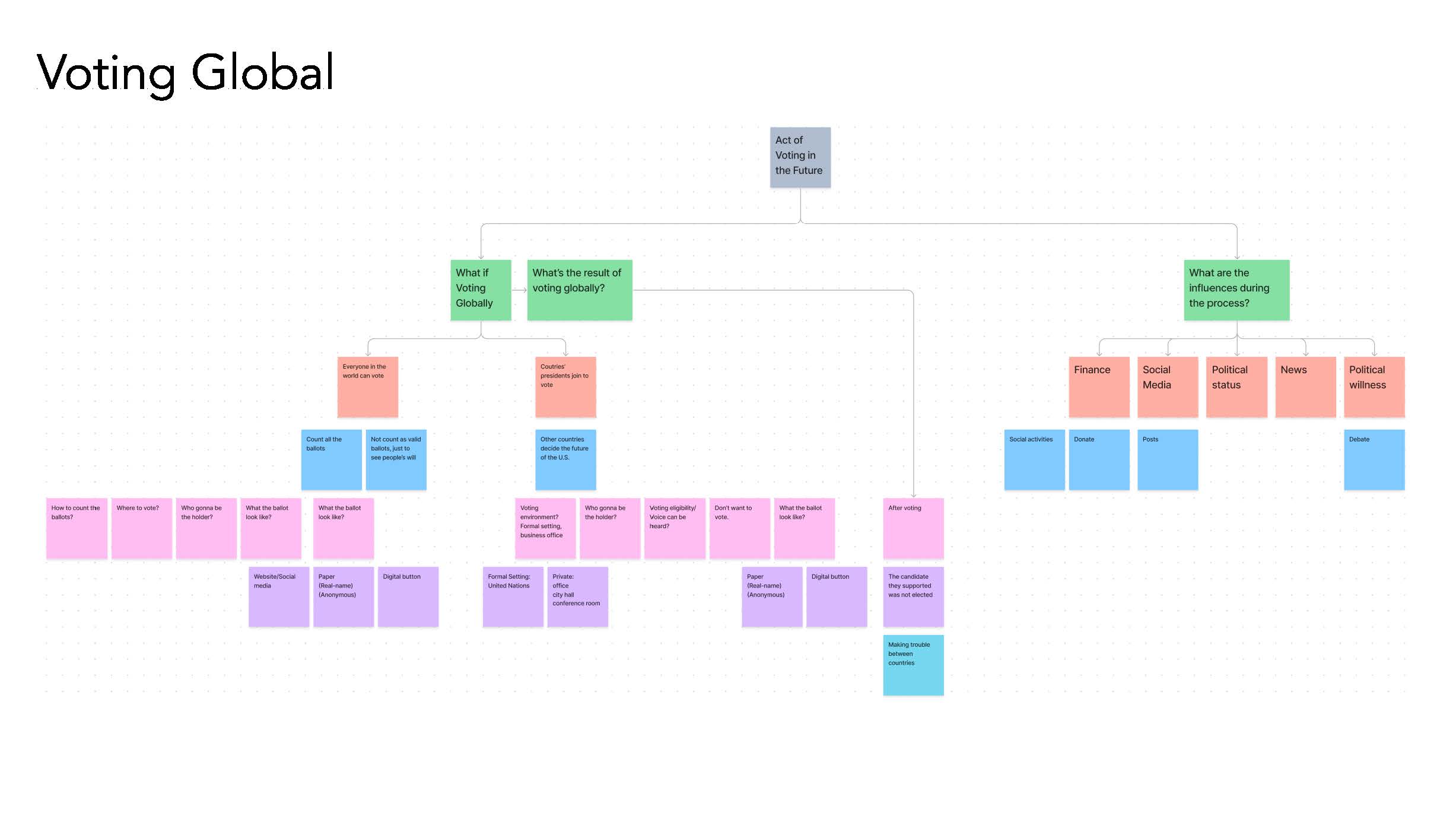Designing Democracy: The Future of Civic Engagement
- Public Policy

In the Summer of 2022, this research-led transdisciplinary Designmatters studio challenged students to explore the past, present and future of democratic participation and civic engagement – and consider how design thinking can play an instrumental role in the election process along with building frameworks and strategies for the future.
Conducting primary investigations about the state of civic participation in the L.A. metro area and with inspiration from expert advisors, students paid close attention to their own exploration processes as they honed their research skills to envision new ways to engage the public in
the political process.
“I wanted to take this studio because I have a big concern about the state of where we are at with our own democracy. I like where this studio took me, by allowing me to explore different avenues that I might not have done before. I realize I have a lot more to research and think about because of this experience.”
Jeremy Zerger (Environmental Design)
Project Brief
This Designmatters studio challenged students to explore different periods of democratic
participation and civic engagement to envision the roles design can play in the election process, in addition to building effective frameworks and strategies for the future.
Inspired by expert advisors from across the political spectrum, students conducted primary research to learn about the current landscape of civic participation in the L.A. metro area. Paying close attention to their own critical research gathering, students examined how creative projects can encourage voter participation as well as increase a deeper understanding of democratic processes.

Research and Project Development
At the studio kickoff, students heard from a panel of subject matter experts who described their unique insight to the democratic process – a discussion that helped the students brainstorm individual research topics they would like to explore in this six-week intensive studio. In attendance was Mari Nakano, the Design Director at Service Design Studio for the NYC Mayor’s Office for Economic Opportunity, Julio Marcial, Senior VP of Programs for Liberty Hill Foundation, Maya Chupkov, Media and Democracy Program Manager at California Common Cause, and Nidhi Singh, Civic Design for Montgomery County.
Students were guided by faculty in techniques to develop their own research projects from the ground up. Through primary and secondary research skills, students would understand more about their individual
creative practices and critical processes as they built on questions and deepened avenues of inquiry. The goal of the studio was not to come to a solution-orientated final or to produce a fully formed campaign or concept. Using the topic of civic engagement, students would learn what it takes to become better researchers, which in turn can lead to becoming more effective and compelling creative thinkers.
“In this iteration of the course, we saw a shift in the way students chose to approach the work: from thinking about how design can improve the processes of democracy (voting campaigns, increasing voter engagement, ballot design) to exploring how design can do political work or expose something about political conditions. As a result, the students have a renewed understanding of the work design can do, and they have articulated research agendas that can live beyond the framework of this course, opening new doors for their future work as artists and designers.”
Candice-Leigh Baumgardner, Faculty
Instructors stressed that through research and analysis, skillful problem solving starts with properly framed questions. Students were encouraged to examine their own ethics and values in relation to the topic and develop individual research projects that reflected their unique creativity and vision of the world. In-class discussions involved the history of U.S. elections and how they have changed over time. Additionally, students analyzed the history of voting rights, civil rights, ballot technologies, media representation and power.
Students decided which forms of research – interviews, observations, surveys, archival research, etc. – would be best suited to their topics. In the field, students engaged and interacted with subjects, and these learnings pointed them to additional questions and additional research.
Some students field-tested rough prototypes; this feedback helped readjust their thinking and opened up new ideation possibilities. Students recognized that each learning outcomes produced insights that moved them forward into other arenas and territories, revealing a deeper complexity of the topic.

“Students [need] historical context for what they are seeing and feeling, so they can craft projects that are meaningful to them and help connect them with the bigger social and political questions being asked about power, across generations and in all corners of the globe. Once they have more context, they immediately start asking the right questions: Can complex systems be changed? If so, how? What are the consequences, intended or not, of such changes? And when they start bringing their creative skills into this questioning process, they generate tremendously compelling research projects.”
Arden Stern, Faculty
Final Outcomes
 close
close
Global Voting
Read moreMingshan Wang (Interaction)
Knowing that one country’s election can have a profound effect on its neighbors and global communities, Wang researched how non-residents’ opinions of elections can offer voting citizens unique perspectives about the issues and candidates.
Voting in America today can be complicated and often people don’t realize their vote does indeed matter. Wang researched the influence of social media around politics and political issues, especially the fun and silly aspects where spoofing is more appealing than straight formal facts. Wang explored how to make voting a global phenomenon by inviting non-voters to cast a ballot in American elections. Through a social media platform, this online voting system (“Everyone can vote!”) is on the surface fun and lively, but the results can point to how issues and candidates are perceived around the world – and help voters understand the ramifications of their vote.
 close
close
Broken Ballots
Read moreCosme Cruz-Ramirez (Product Design with Designmatters Minor in Social Innovation)
Examining the current landscape of apathetic voters overly complicated ballots, and ballot casting procedures, Cruz-Ramirez explored how parody could invigorate participants to better connect with the democratic process. Cosme researched how misinformed action affects individual voters but also how an eagerness of civic and governmental officials to make voting easier through the ballot system can be detrimental. They traced the journey a ballot takes from design to final audit/counting after an election; he also examined the digital and paper ballots.
In response to the popular “I Voted!” stickers, Cruz-Ramirez wondered about a “I Didn’t Vote” sticker – which led them to brainstorm ideas that directly contradict conventional thinking about how to entice voters. Instead of making the voter ballot friendly and easy, how can we make it even more difficult? “What is the best way to do this wrong?” became his design-thinking which opened up avenues of parody that could be eye-catching and purposely disruptive. Cruz-Ramirez created prototypes that reflected this opposite direction not just as comedic, but also as a way to start discussions on the democratic process and ways to ‘break the system’ which can encourage more participation. Cosme’s next steps will be to develop workshop opportunities around the topic and prototype refinement.
 close
close
Design, Democracy, Capitalism and Community
Read moreJeremy Zerger (Environmental Design)
Jeremy Zerger examined how physical locations can strengthen communities and foster relationships between people, a concept relevant in today’s individualized society. Zerger explored how democracy is ever-changing and that social infrastructure relies on places that encourage one-on-one contact, mutual support and collaboration among neighbors. Zerger investigated the rise of libraries, noting the altruistic Carnegie library system as an example.
Taking urban sociologist Ray Oldenburg’s concept of the Third Place, Zerger examined what existing locations today serve as a place where individuals can come together where they can be themselves and engage in healthy discourse: community centers, libraries, parks and coffee shops.
Some of those locations are consumer-driven which prompts the query about how consumerism interacts with democratic spaces which are necessary for a healthy democracy. What is the balance? What is valued more: a consumer or a citizen?
Zerger honed his attention to shopping malls, which were introduced as town centers in the 60s, had its heydays in the 1970’s and 80s, but are now are shuttering. He wondered about the role malls played in the decline of the middle class. Finally, Jeremy reimagined a mall from his hometown of Hutchinson, Kansas, plotting how new spaces could encourage local interaction, community-based activities and a “town center” aspect that is missing from so much of the American experience today.